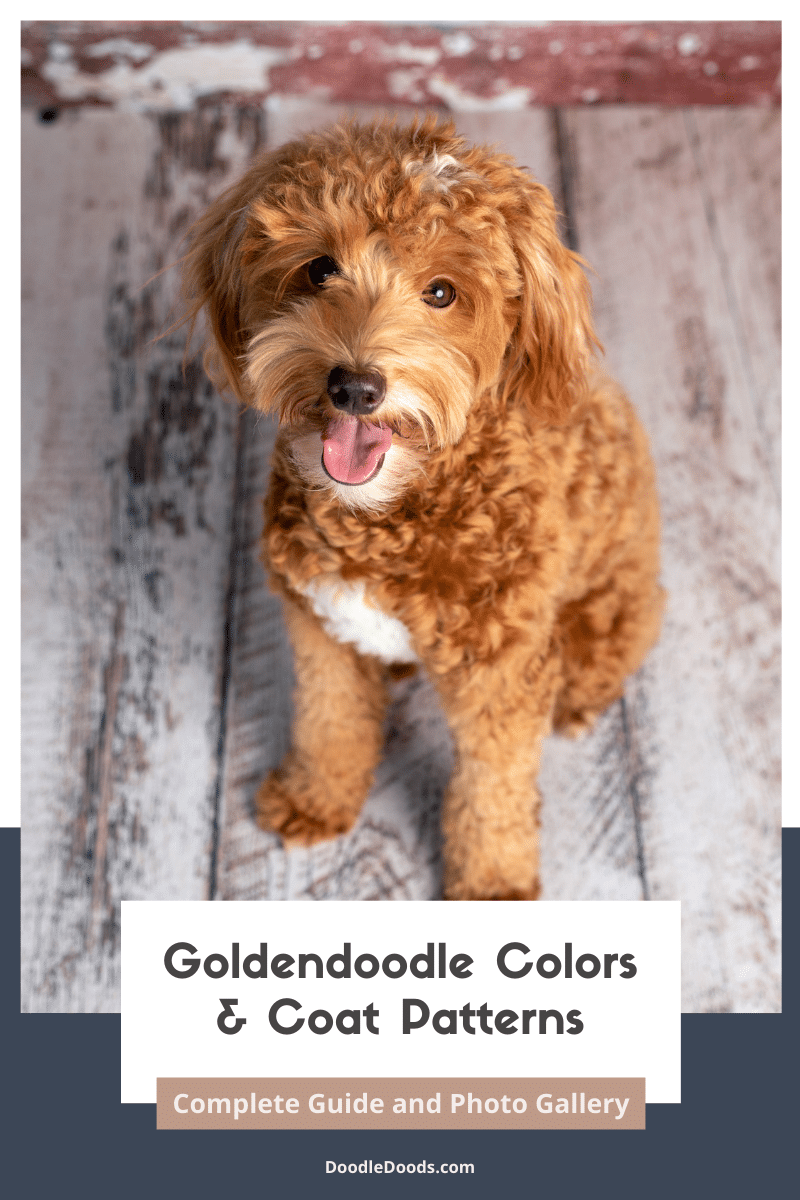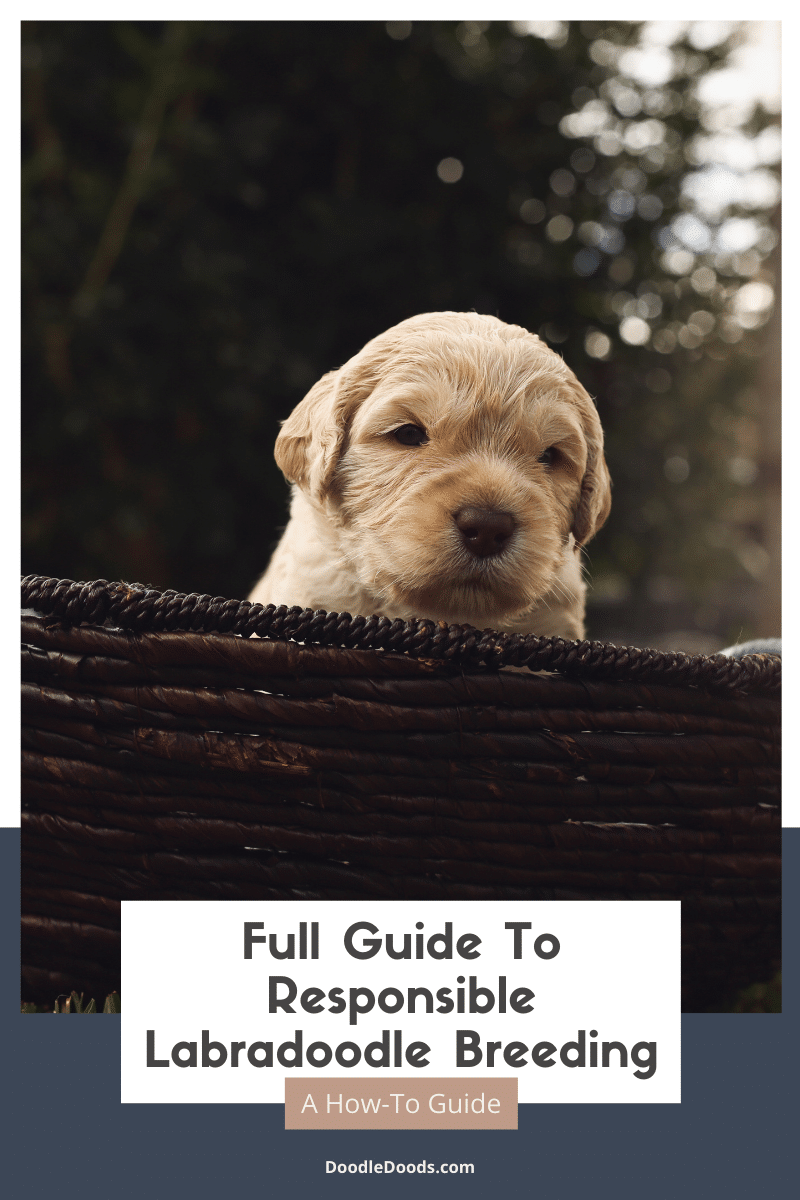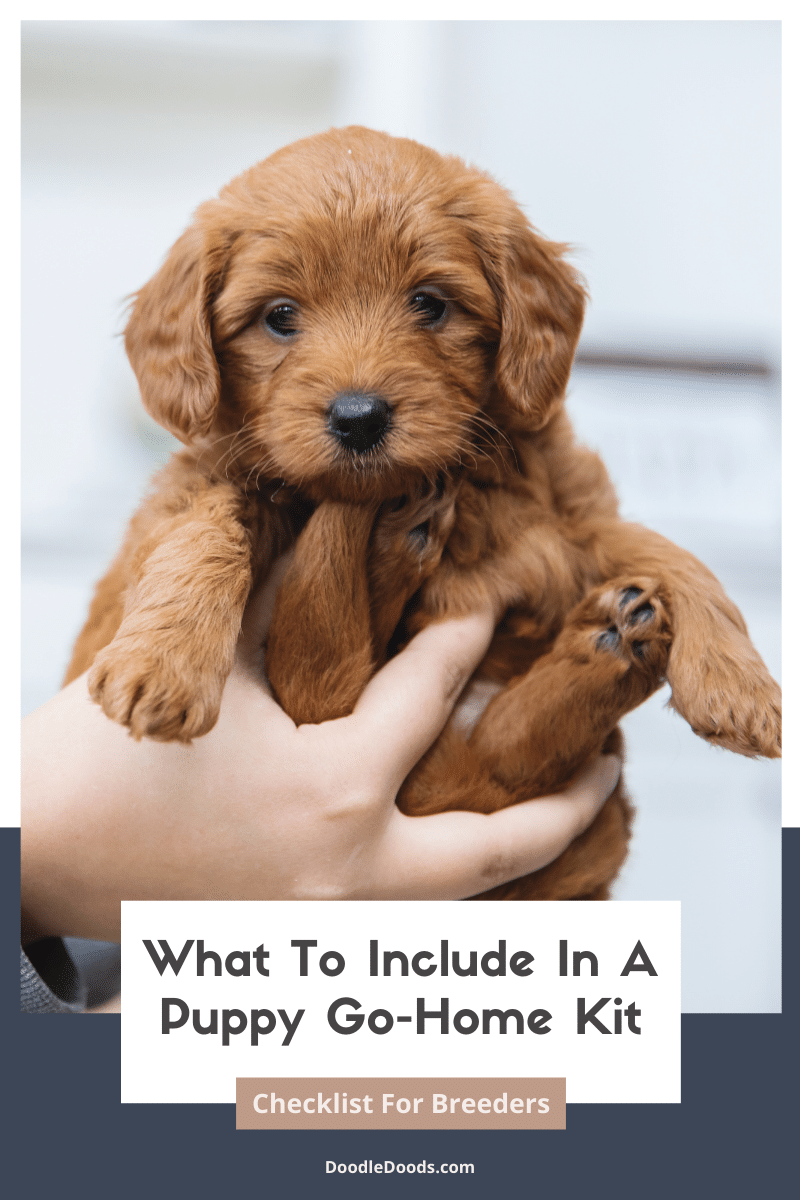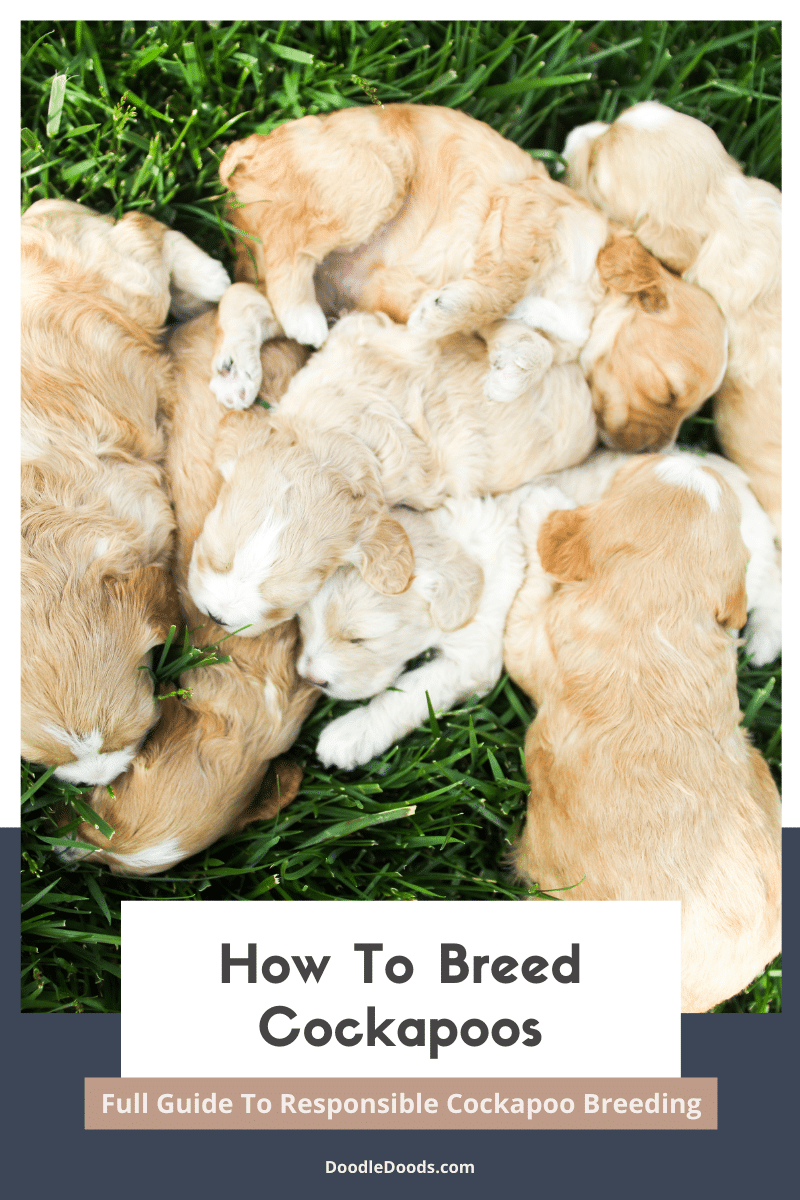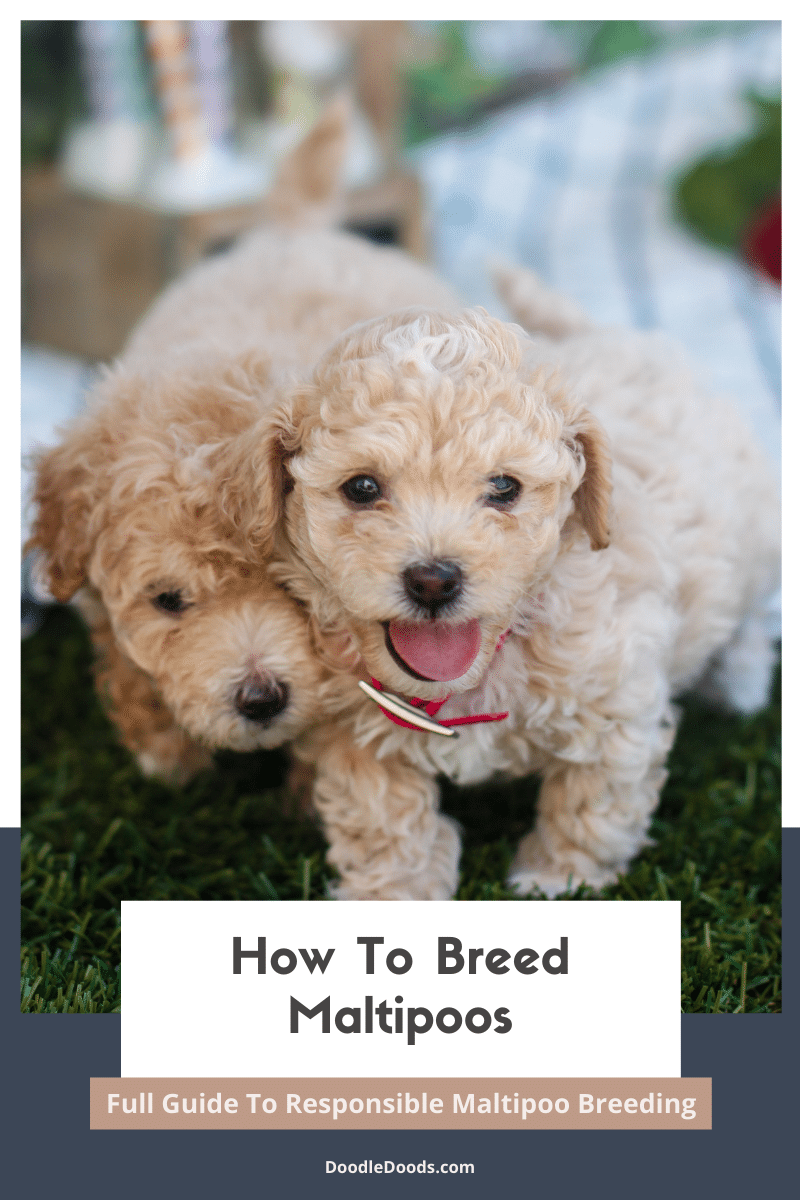Are you thinking about breeding Goldendoodles? It’s a big decision, and there’s a lot to consider before you get started. This guide will walk you through everything you need to know about responsible Goldendoodle breeding. We’ll cover the basics of genetics, breeding plans, and health screening for your dogs.
Breeding Goldendoodles can be a rewarding experience, but it’s important to do it responsibly. With this guide, you can be sure that your puppies will have the best chance for a healthy start in life. We’ll discuss everything from choosing a mate to caring for puppies. So, whether you’re a first-time breeder or just doing some research, be sure to keep on reading.
Table of Contents
- Goldendoodle Breeding: Intro
- Goldendoodle Breeding How-To
- Decide What Type Of Goldendoodle You Want To Breed
- Goldendoodle Breeding Chart: All About Goldendoodle Generations
- The Backbone Of Responsible Goldendoodle Breeding: Health & Genetic Testing
- Consider The Parents’ Personality & Temperament
- Team Up With A Licensed Veterinarian
- Learn The Basics Of Early Socialization, Training, & Other Forms Of Enrichment Methods
- Stock Up On Breeding Supplies
- Make Sure You Follow The Law
- Build Trust With Your Potential Clients
- Find Good Homes For Your Puppies
- Create A Breeding Plan
- What Is The Best Age To Breed A Goldendoodle?
- How Much Does It Cost To Breed A Goldendoodle?
- Goldendoodle Breeding: Frequently Asked Questions
- Goldendoodle Breeding: Final Thoughts
Goldendoodle Breeding: Intro
Goldendoodles are a hybrid breed of dog, created by breeding a Golden Retriever with a Poodle. They are often chosen as pets because they are considered to be hypoallergenic thanks to their low shedding coats. Of course, we cannot forget the Goldendoodle’s wonderful temperament. They’re sweet, fun-loving, and highly intelligent companions. They also make excellent emotional support dogs, therapy dogs, and guide dogs. But, if you’re thinking about breeding Goldendoodles yourself, there’s a lot to consider before getting started.
Goldendoodle Breeding How-To
When it comes to responsible Goldendoodle breeding, it isn’t just about having two cute dogs mate. After all, bringing a new litter of puppies into this world is a huge responsibility. Especially if we consider how many dogs are waiting for their forever homes in shelters, dog rescues, and even on the streets.
If you’ve decided to venture into the world of Goldendoodle breeding, it’s vital that you do it responsibly. To do that, you’ll need to educate yourself and conduct extensive research before getting started. Here’s how you can set yourself and your pups up for success.
Decide What Type Of Goldendoodle You Want To Breed
When it comes to Goldendoodles, there are four sizes that you can choose from – Standard, Medium, Miniature, and Toy. You’ll also need to decide on the coat type and color that you want to breed for.
Keep in mind that the size of the Goldendoodle will be determined by the size of the parents. So, if you want to breed Standard Goldendoodles, you’ll need to use a Standard Poodle in the mix.
The same goes for the other three sizes. If you want to produce Mini or Medium Goldendoodles, then you’ll have to use smaller Miniature and Moyen (a.k.a Medium) Poodles in your breeding program, respectively. If you want to breed the smallest Toy Goldendoodles, you’ll need to have the smallest Toy Poodle as one of the parents*.
*When breeding two different sized dogs, the smaller dog should always be used as the sire (father). This is to prevent physical risk to the dam (mother).
Since Standard Poodles and Golden Retrievers are in a very similar size range, these pups can be created as first-generation or later generations. However, when breeding smaller Mini and Toy Goldendoodles, it’s wise to breed backcross generations so that the parents are of similar size. More on that later.
But, what if you want to produce all four sizes of Goldendoodles? In that case, you’ll need to have all four sizes of Poodles in your breeding stock. Below is a helpful Goldendoodle size chart with all the possible varieties. It shows the average weights by age (in weeks), by size of dog, which we’ve been collecting from our Doodle Weight Prediction Calculator. (For the most up-to-date info about this chart, visit our Goldendoodle size guide.)
As for the coat type and color, that will be determined by the genes of the parents. So, if you want to breed Goldendoodles with a certain coat type or color, you’ll need to make sure that the parents carry those genes. We’ll cover the genetics portion of Goldendoodle breeding a bit later on in this article.
Goldendoodle Breeding Chart: All About Goldendoodle Generations
As we briefly mentioned, you can breed different Goldendoodle generations. The most common Goldendoodle generations are F1, F1b, F1bb, F2, and Multigen.
To help you understand the difference between all of these generations, we’ve created a Goldendoodle breeding chart. This will show you how each generation is made as well as what to expect in terms of size, coat type, and temperament.
| 1st Parent | 2nd Parent | % Golden Retriever* | % Poodle* | Coat Type | |
| F1 Goldendoodle (first-generation) | Golden Retriever | Poodle | 50% | 50% | Most likely: wavy/fleece |
| F1B Goldendoodle (first-generation backcross) | F1 Goldendoodle | Poodle | 25% | 75% | Highly likely: curly/wool |
| F1BB Goldendoodle (first-generation backcross backcross) | F1B Goldendoodle | Poodle | 12.5% | 87.5% | Almost guaranteed: curly/wool |
| F2 Goldendoodle (second-generation) | F1 Goldendoodle | F1 Goldendoodle | 50% | 50% | Most likely: wavy/fleece |
| F2B Goldendoodle (second-generation backcross) | F1 Goldendoodle | F1B Goldendoodle | 37.5% | 62.5% | Most likely: curly/wool |
| F2B Goldendoodle (alternate cross) | F2 Goldendoodle | Poodle | 25% | 75% | Highly likely: curly/wool |
| F3 / Multigen Goldendoodle | F1B Goldendoodle or higher | F1B Goldendoodle or higher | Varies | Varies | Varies |
Goldendoodle generations help us achieve more control over the litter and how the puppies may turn out. Of course, a Goldendoodle’s generation isn’t a definitive way of predicting their size, coat type, shedding levels, or appearance. However, it does help us predict the outcome a bit better.
For instance, it may be fairly tricky trying to figure out how a litter of F1 Goldendoodles may turn out, as they’re a 50-50 mix of both purebred Poodle and Golden Retriever. However, if we’re crossing an F1 Mini Goldendoodle back to a Miniature Poodle, it’s safe to assume that the puppies will likely inherit the Poodle’s smaller size and a curlier low shed coat.
The Backbone Of Responsible Goldendoodle Breeding: Health & Genetic Testing
When it comes to Goldendoodle breeding, choosing healthy parents is essential. After all, you want your puppies to be as healthy as possible. To ensure that your dogs are healthy, you’ll need to have them screened for any genetic diseases before breeding them.
The most common health problems that Goldendoodles can inherit are hip and elbow dysplasia, various eye diseases like PRA and cataracts, heart diseases, Addison’s Disease, and von Willebrand’s Disease (vWD). If you plan to breed smaller Mini and Toy Goldendoodles, the parents should also be tested for patellar luxation.
Hip and elbow dysplasia are joint problems that can cause a lot of pain and mobility issues for your dog. Von Willebrand’s disease is a blood disorder that can cause excessive bleeding. Of course, these are just some of the health problems that Goldendoodles can inherit from their parents. That’s why it’s so important to have your dogs screened for any genetic diseases before breeding them.
The genetic testing should be accepted by the OFA (the Orthopedic Foundation for Animals). For instance, many breeders have their breeding stock tested through Embark, as they’re also OFA accepted. The Goldendoodle Association of North America has a great overview of all the testing that breeders should do before breeding any litters.
Coat Testing
In addition to conducting genetic testing for various hereditary conditions, it also may be reasonable to test your potential breeding dogs for coat genetics.
As we’re combining two different purebred dogs, the outcome can vary significantly. So, if your goal is to breed hypoallergenic and low-shedding Goldendoodles, you’d want to make sure that the parents carry the right genes. For instance, some Goldendoodles may still inherit the Golden Retriever’s straight coat or even a flat coat.
Moreover, the highly coveted merle coat does also come with potential risks. That’s why ethical Goldendoodle breeders never mate two dogs carrying the merle gene, as this can increase the risk of blindness and deafness in puppies.
Interestingly enough, it’s also not uncommon for Goldendoodles to carry the infamous Poodle fading gene. Essentially, this means that darker-colored Doodles may start to fade lighter over time. Just something to keep in mind!
Consider The Parents’ Personality & Temperament
When considering Goldendoodle breeding, it’s important to take the parents’ personalities and temperaments into account. After all, these traits will be passed down to the puppies.
If you want a calm and gentle Goldendoodle, look for parents with these qualities. On the other hand, if you’re hoping for a Goldendoodle with lots of energy and spunk, choose parents that are high-spirited and playful.
Of course, every Goldendoodle is unique and will have its own individual personality. But by choosing parents with the qualities you’re looking for, you can help increase the chances of getting the type of Goldendoodle you’re hoping for.
Team Up With A Licensed Veterinarian
Goldendoodle breeding can be a rewarding experience, but it’s important to team up with a licensed veterinarian to ensure the health and safety of the dogs involved. A veterinarian can help you determine whether Goldendoodle breeding is right for you, and can provide guidance on how to care for your dogs during pregnancy and childbirth.
They can also help you select the best Goldendoodle studs and dams for your breeding program, and can provide advice on how to raise Goldendoodle puppies. They’ll also keep an eye on the puppies’ development, administer all age appropriate vaccinations and dewormings.
By working with a licensed veterinarian, you can be sure that your Goldendoodles are healthy and happy, and that their puppies will have the best possible start in life.
Learn The Basics Of Early Socialization, Training, & Other Forms Of Enrichment Methods
If you’re thinking about breeding Goldendoodles, you cannot ignore the importance of early socialization and training. Starting the pups on training, socialization, and other forms of enrichment methods from an early age sets them up for success. Not only is this crucial to raise well-behaved dogs, it also shapes the puppies’ emotional and mental wellbeing for the rest of their lives.
Training and socialization help teach dogs how to behave around people and other animals, and can help prevent behavioral problems down the road. Enrichment methods, such as providing toys and activity puzzles, can keep dogs mentally stimulated and help reduce boredom-related problems. Introducing puppies to regular body handling will also help them get used to human interactions and being close to people of all ages. Introducing puppies to grooming activities will also help familiarize and acclimate them to a lifetime of necessary grooming.
Equally important are crate training, potty training, and obedience training, which will greatly improve the puppies’ confidence and make their transition much smoother once they go to their forever homes.
If you’re not quite sure where to start, the Puppy Culture program is an excellent resource that many breeders have found helpful. There are also other puppy curriculums, such as the Badass Breeder’s Guide or Avidog. You may also want to look into the Early Neurological Stimulation (ENS) method, which has shown to improve the puppies’ heart health, tolerance to disease, and improve their resistance to stress.
Stock Up On Breeding Supplies
Needless to say, before you start breeding Goldendoodles, you need to make sure you have all the necessary supplies to do so. First, make sure you have enough room in your house to raise the dogs. You should also have enough space for crates, toys, and dog beds. Responsible breeders raise their puppies in a safe and nurturing home environment. This way, the pups get to join in all the fun and get used to a regular, busy home environment from an early age.
Secondly, you’ll need to stock up on all the necessary breeding supplies, such as dog beds, food and water bowls, crates, grooming tools, leashes and harnesses, dog food and puppy food, first aid supplies, puppy toys, and more. In addition to that, you should purchase whelping boxes, whelping pads, disposable gloves, heating pads and cooling pads, sanitizers, bulb syringes, clean blankets, bottle and syringe feeding supplies. Again, GANA has an excellent comprehensive list of items that a responsible Goldendoodle breeder should stock up on.
Make Sure You Follow The Law
If you’ve decided that Goldendoodle breeding is your true calling, then you need to make sure you’re following all the relevant laws and regulations. Different states and countries have different laws when it comes to breeding dogs. So, it’s important that you do your research and find out what applies to you.
In general, there are a few things you need to keep in mind when breeding Goldendoodles. First of all, both the sire and dam must be health tested and cleared of any genetic diseases before breeding can take place. Secondly, your state may require you to microchip the parents and puppies – this is also a great safety measure in case any of the dogs manage to get out of the house. And finally, your house should be clean and safe so that the dogs and puppies are not exposed to health hazards.
Build Trust With Your Potential Clients
When you’re ready to start finding buyers for your puppies, it’s important that you build trust with your potential clients. After all, they are entrusting you with their new family member, and they need to know that you will take good care of them.
One of the best ways to do this is by being completely transparent about your breeding program. Make sure you keep good records of the health tests, vaccinations, and dewormings for both the parents and puppies. You should also provide a contract that outlines your refund and return policy, as well as what is included in the purchase price (e.g., food, toys, etc.). Having a good website with all of the essential information will help you build trust with your potential customers.
In addition to that, it’s a good idea to stay in touch with your buyers even after they’ve taken their puppy home. This way, you can answer any questions they may have and help them out if they’re having any problems.
Provide Health Guarantees
Responsible Goldendoodle breeders provide health guarantees for their puppies. This way, the buyers know that they can get a refund or replacement if the puppy has inherited any serious genetic defects. Most reputable breeders will offer a one or two-year genetic and congenital health guarantee, although some may offer longer periods.
Register With Clubs & Associations
Last but not least, if you want to be a responsible Goldendoodle breeder, it’s a good idea to register with clubs and associations such as the Goldendoodle Association or North America (GANA), American Kennel Club (AKC), Continental Kennel Club (CKC), or the Good Dog’s Responsible Breeding Program. This way, you can show potential buyers that you are a serious breeder who is dedicated to breeding healthy and happy Goldendoodles following responsible breeding guidelines.
Find Good Homes For Your Puppies
Once your Goldendoodles are born, it’s important to find good homes for them. After all, you don’t want your puppies to end up in a shelter or rescue. Or worse, with irresponsible puppy owners or in puppy mills.
There are a few things you can do to find good homes for your puppies. First, you can screen potential buyers to make sure they’re a good fit for one of your pups. Second, you can require that potential buyers sign a contract that outlines their responsibilities as an owner.
By taking these precautions, you can help ensure that your Goldendoodles go to good homes where they’ll be loved and cared for.
Create A Breeding Plan
Once you’ve chosen your breeding stock and had them screened for any genetic diseases, it’s time to create a breeding plan. This is essentially a roadmap that will guide you through the process of breeding Goldendoodles.
When creating your breeding plan, you’ll need to decide how many litters you want to produce each year and what type of Goldendoodles you want to breed. You’ll also need to decide how you’re going to find homes for all of your puppies, and how much you will charge per puppy.
Creating a breeding plan may seem like a lot of work, but it’s essential if you want to breed Goldendoodles responsibly.
What Is The Best Age To Breed A Goldendoodle?
If you decide to start breeding Goldendoodles, it’s crucial that you don’t start too early. First of all, Goldendoodles reach sexual maturity around 6 months of age. However, this isn’t yet the time to start breeding new litters.
Responsible Goldendoodle breeding guidelines recommend that breeding shouldn’t start before the dams and sires turn two years old. By this time, the parents are both physically and mentally mature enough to handle the pregnancy. Moreover, responsible breeders usually only have their dams breed 4 to 6 litters before they retire from breeding. In addition to that, there should be enough time between each litter for the mama to recover.
How Much Does It Cost To Breed A Goldendoodle?
If you adopt a pet Goldendoodle, you can expect to pay $1,500 and $5,000 for a puppy. However, adopting a Goldendoodle with breeding rights will cost you a lot more, usually a few thousand dollars extra. In addition to that, you’ll have to take into account the necessary health and genetic testing that’ll cost about $1,000 for one parent dog.
On top of that, you’ll also want to take into account all of the costs of breeding supplies, prenatal care, dog food, veterinary care, and other items. Obviously, the overall cost of living in your area will also dictate the costs of Goldendoodle breeding. So, breeding a litter of Goldendoodles could reach as high as $9,000.
Goldendoodle Breeding: Frequently Asked Questions
The litter size of a healthy Goldendoodle mama ranges between 3 to 8 puppies per litter. However, the average usually sits between 5 to 7 pups per litter.
If you cross an F1 and F2 Goldendoodle, this would usually be considered as a Multigenerational Goldendoodle.
Absolutely, you can breed two Goldendoodles. However, you should always have health and DNA tests done on your potential breeding dogs to rule out any hereditary conditions.
Goldendoodle Breeding: Final Thoughts
As you can see, there’s a lot to consider before breeding Goldendoodles. But if you’re willing to put in the time and effort, then it can be a very rewarding experience. Just remember to always put the health and wellbeing of the dogs first. Goldendoodle breeding is a big responsibility, but if you follow these tips, you’ll be well on your way to breeding healthy and happy puppies that will bring joy to their new families.
The information on this page is for informational purposes only. It is not intended to be a substitute for qualified professional veterinary advice, diagnosis, or treatment. Always seek the advice of your veterinarian or other qualified animal health provider with any questions you may have.


